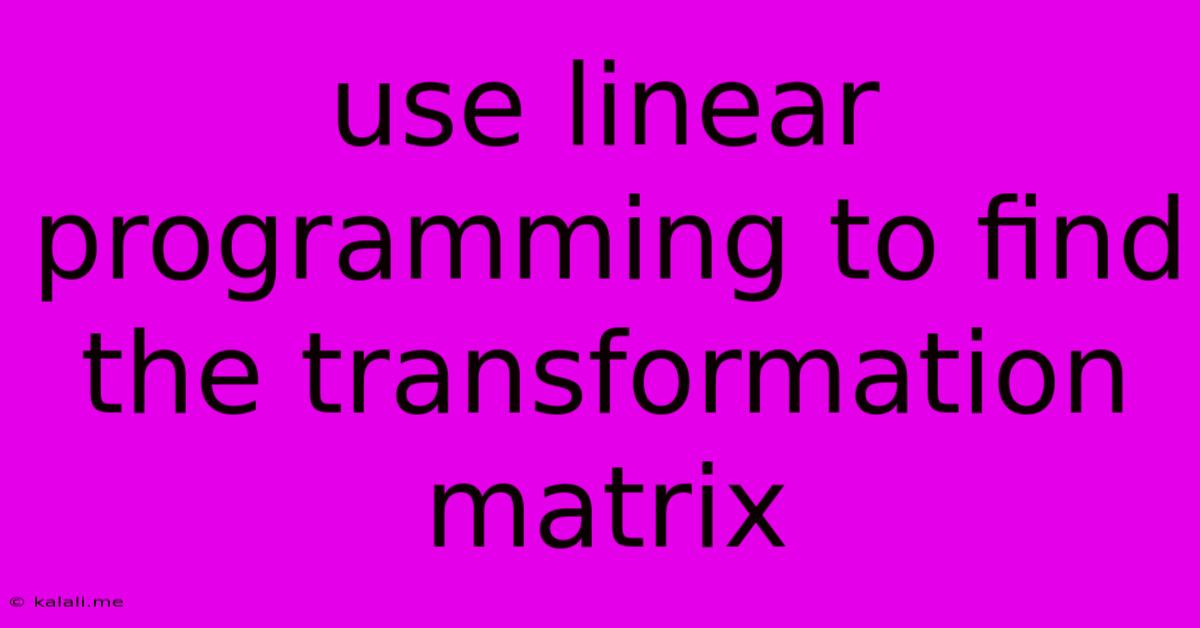Use Linear Programming To Find The Transformation Matrix
Kalali
May 23, 2025 · 4 min read

Table of Contents
Using Linear Programming to Find the Transformation Matrix
This article explores how linear programming (LP) can be used to determine a transformation matrix. This is a powerful technique applicable in various fields, including computer vision, robotics, and image processing, where finding the optimal transformation between two sets of data points is crucial. We will delve into the mathematical formulation and provide a practical understanding of this method. Understanding this process can improve your image registration, object recognition, and motion tracking capabilities.
What is a Transformation Matrix?
A transformation matrix is a mathematical representation of a geometric transformation. It's a matrix that, when multiplied by a coordinate vector, transforms that vector to a new location. Common transformations include translation, rotation, scaling, and shearing. Finding the "best-fit" transformation matrix often involves minimizing the differences between transformed points and their corresponding target points.
Linear Programming Fundamentals
Linear programming is a mathematical method for achieving the best outcome (such as maximum profit or lowest cost) in a mathematical model whose requirements are represented by linear relationships. Key components include:
- Objective Function: This function represents what we want to optimize (minimize or maximize). In our case, it will represent the error between transformed and target points.
- Decision Variables: These are the unknowns we need to solve for—the elements of the transformation matrix.
- Constraints: These are limitations or restrictions on the decision variables. These might involve restrictions on the range of transformation parameters or relationships between matrix elements.
Formulating the Linear Program
Let's assume we have two sets of corresponding points: {xᵢ} and {yᵢ}, where xᵢ represents a point in the source coordinate system and yᵢ its corresponding point in the target coordinate system. We want to find a transformation matrix, T, such that Txᵢ ≈ yᵢ for all i.
The objective function aims to minimize the total error between the transformed points and the target points. We can use a sum of squared errors, which is a common approach:
Minimize: ∑ᵢ ||Txᵢ - yᵢ||²
This objective function is not inherently linear. However, we can approximate it using linear constraints or reformulate the problem using techniques like least squares, which can be solved efficiently with linear programming algorithms. Linear programming solvers are readily available in many mathematical software packages. It is important to select appropriate norms (e.g., L1 or L2 norm) to account for outliers and robustness. The choice depends heavily on the nature of the data and the desired properties of the transformation.
Constraints and Considerations
Constraints are crucial in shaping the solution. They might include:
- Matrix structure: Depending on the type of transformation (e.g., rigid transformation, affine transformation), the transformation matrix
Twill have specific properties (e.g., orthogonality for rotations). These properties can be incorporated as constraints. - Parameter bounds: We might want to limit the range of possible values for the elements of
Tbased on physical or logical constraints. - Regularization: Adding regularization terms to the objective function can help prevent overfitting and improve the generalization capability of the transformation.
Solving the Linear Program
Once the linear program is formulated, we can use a suitable solver (e.g., simplex method, interior-point method) to find the optimal transformation matrix T. Many software packages, including those in Python's scipy.optimize module and MATLAB, provide efficient implementations of linear programming solvers.
Applications and Extensions
This method finds applications in diverse areas:
- Image Registration: Aligning images taken from different viewpoints or at different times.
- Object Recognition: Finding the transformation between a template object and its instances in an image.
- Robotics: Determining the robot's pose (position and orientation) relative to its environment.
- 3D Modeling: Transforming 3D models to fit real-world data.
This method can be extended to handle more complex transformations and incorporate additional information such as point correspondences with uncertainty. The choice of optimization method and the constraints included will significantly affect the accuracy and robustness of the resulting transformation matrix.
By carefully defining the objective function, constraints, and employing appropriate linear programming techniques, you can accurately and efficiently determine a transformation matrix, providing a powerful tool for various applications. Remember to consider the nuances of your specific problem when selecting the most appropriate method and constraints.
Latest Posts
Latest Posts
-
Mother And I Or Mother And Me
Jul 18, 2025
-
How Many Oz In One Water Bottle
Jul 18, 2025
-
How Many Dimes In A 5 Roll
Jul 18, 2025
-
How Do You Say Basil In Spanish
Jul 18, 2025
-
How Many Cookies Are In A Dozen
Jul 18, 2025
Related Post
Thank you for visiting our website which covers about Use Linear Programming To Find The Transformation Matrix . We hope the information provided has been useful to you. Feel free to contact us if you have any questions or need further assistance. See you next time and don't miss to bookmark.